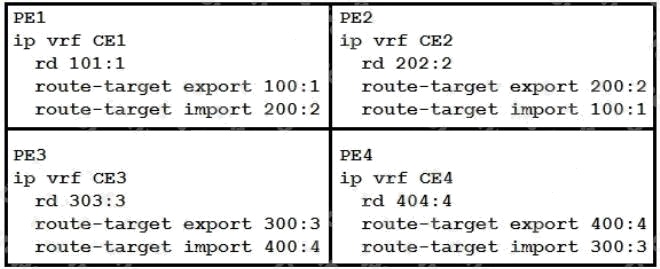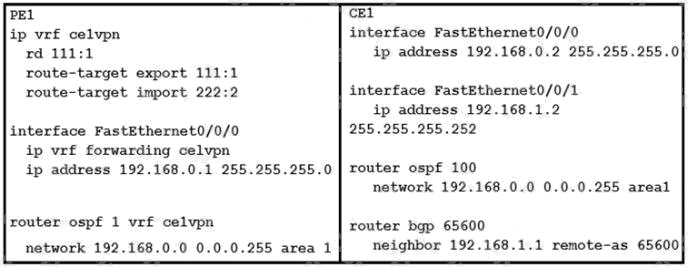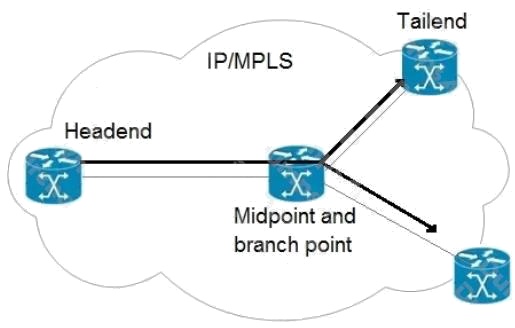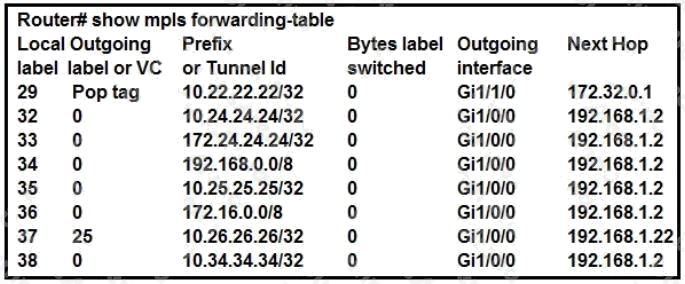cisco 300-515 practice test
Implementing Cisco Service Provider VPN Services (SVPI)
Last exam update: Jul 20 ,2024
Question 1 Topic 1
Topic 1
Which utility can you use to validate an LSP in an MPLS environment?
- A. uRPF
- B. MPLS LSP ping
- C. logging
- D. RSVP
Answer:
B
Question 2 Topic 1
Topic 1
What is the primary function of a VRF on a router?
- A. It enables the router to support multiple separate routing tables, which allows the device to handle overlapping IP addresses.
- B. It enables a router to run BGP and a distance vector routing protocol at the same time, which allows it to serve as a VPN endpoint between remote sites.
- C. It enables a router to configure VLANs locally, which provides segregation between networks.
- D. It enables the router to provide faster switching through the network by using labels to identify the input and output interfaces for neighbor routers.
Answer:
A
Question 3 Topic 1
Topic 1
Which two statements describe primary differences between MPLS Layer 2 and Layer 3 VPNs? (Choose two.)
- A. Layer 2 VPNs use IPsec tunneling, but Layer 3 VPNs use L2TPv3 tunneling.
- B. Layer 2 VPNs use AToM, but Layer 3 VPNs use MPLS/BGP.
- C. Layer 2 VPNs use BGP, but Layer 3 VPNs use VPLS.
- D. Layer 2 VPNs use L2TPv3 tunneling, but Layer 3 VPNs use GRE tunneling.
- E. Layer 2 VPNs use IPsec tunneling, but Layer 3 VPNs use pseudowires to provide tunneling.
Answer:
B D
Question 4 Topic 1
Topic 1
Refer to the exhibit. A network engineer has been called to configure the four PE devices in order to enable full
communication among the four CE devices connected to them. While starting to configure, he experienced a connectivity
issue. Which two tasks should the engineer perform in order to begin the process correctly? (Choose two.)
- A. Configure PE3 to export route-targets 100:1 and 200:2.
- B. Configure PE3 to import route-targets 100:1 and 200:2.
- C. Configure PE4 to import route-targets 101:1 and 202:2.
- D. Configure PE2 to export route-targets 300:3 and 400:4.
- E. Configure PE1 to import route-targets 300:3 and 400:4.
Answer:
A B
Question 5 Topic 1
Topic 1
Refer to the exhibit. If the two devices are operating normally, which two conclusions can you draw from this configuration?
(Choose two.)
- A. CE1 must use OSPF to establish a neighbor relationship with PE1.
- B. PE1 labels the routes it learns from CE1 with the route-target 222:2 and shares them with its VPNv4 peers.
- C. PE1 labels the routes it learns from CE1 with the route-target 111:1 and shares them with its VPNv4 peers.
- D. The PE-CE routes between the devices are being exchanged by OSPF
- E. CE1 is supporting CSC.
Answer:
A D
Question 6 Topic 1
Topic 1
Which two frames can be configured on an Ethernet flow point? (Choose two.)
- A. of a specific VLAN
- B. with different type of service values
- C. with identical type of service value
- D. with different class of service values
- E. with no tags
Answer:
A E
Explanation:
Reference: https://www.cisco.com/c/en/us/td/docs/ios-xml/ios/cether/configuration/xe-3s/asr903/16-5-1/b-ce-xe-16-5-
asr900/trunk-efp-support.html
Question 7 Topic 1
Topic 1
In an Ethernet Virtual Circuit environment, which restriction do bridge domains have when STP is running?
- A. The STP mode must be RSTP or PVST+
- B. Bridge domains must be mapped to a different VLAN.
- C. The STP mode must be MSTP
- D. Bridge domains must belong to different MST instances.
Answer:
C
Explanation:
Reference: https://www.cisco.com/c/en/us/td/docs/routers/asr920/configuration/guide/ce/b_ce_xe-313s-asr920-
book/b_ce_xe-313s-asr920book_chapter_01.html#reference_770349446ED24E83821EF701DDC46BFD
Question 8 Topic 1
Topic 1
Refer to the exhibit. An engineer is implementing an MPLS P2MP TE solution. Which type of router can serve as the
midpoint router and the tailend router in this P2MP TE network implementation?
- A. headend
- B. source
- C. transit
- D. bud
Answer:
D
Explanation:
Reference: https://www.cisco.com/c/en/us/td/docs/routers/asr920/configuration/guide/mpls/mp-te-path-setup-xe-3s-asr920-
book/mp-te-path-setup-xe-3s-asr920-book_chapter_01.html
Question 9 Topic 1
Topic 1
An engineer is investigating an EVPN traffic flow issue. Which type of traffic should the engineer allow in an EVPN Tree
Service in order to fix this issue?
- A. known unicast from a leaf to another leaf
- B. unknown unicast from a leaf to another leaf
- C. multicast from a leaf to another leaf
- D. known unicast from a root to another root
Answer:
D
Explanation:
Reference: https://tools.ietf.org/html/draft-ietf-bess-evpn-etree-14
Question 10 Topic 1
Topic 1
An engineer is investigating an MPLS LDP issue. Which command should an engineer use on a Cisco IOS XE device to
display the contents of the LFIB?
- A. show mpls forwarding-table
- B. show mpls ldp neighbors
- C. show mpls ldp labels
- D. show mpls ldp bindings
Answer:
A
Explanation:
Reference: https://www.cisco.com/c/en/us/td/docs/ios-xml/ios/mpls/command/mp-cr-book/mp-s2.html
Question 11 Topic 1
Topic 1
Refer to the exhibit. Which statement about this output is true?
- A. The router IP 192.168.1.2 sent an implicit null, and the output is from the penultimate LSR.
- B. The adjacent router is the egress LSR and has mpls ldp explicit-null configured.
- C. The adjacent LSR router configured mpls label range 0.
- D. The zero in the second column is the normal behavior of an egress router LSR.
Answer:
B
Question 12 Topic 1
Topic 1
An engineer is troubleshooting an ongoing network outage. Which command should he use that can display the live log files
for a process or service running on a network device?
- A. traceroute
- B. show run
- C. ping
- D. debug
Answer:
D
Question 13 Topic 1
Topic 1
Which tool identifies the point of failure in a P2MP LSP from the ingress LSR?
- A. Jitter TLV
- B. SPAN
- C. P2MP traceroute
- D. P2MP ping
Answer:
C
Explanation:
Reference: https://www.cisco.com/c/en/us/td/docs/routers/asr9000/software/asr9k_r5-3/mpls/configuration/guide/b-mpls-
cg53x-asr9k/b-mpls-cg53x-asr9k_chapter_01000.html
Question 14 Topic 1
Topic 1
In a typical service provider environment, which two tools are used to help scale PE router connectivity requirements?
(Choose two.)
- A. route reflectors
- B. VPNv4 address family
- C. originator ID
- D. cluster ID
- E. confederations
Answer:
A E
Question 15 Topic 1
Topic 1
An ISP provides a major client MPLS VPN for managed services. The MPLS engineering team needs to use the advanced
VPN feature of selective VRF import so that only specific prefixes are present in the required VPNs.
Which aspect of this feature must the team consider?
- A. A route must pass the import route map first and then the route target import filter.
- B. The routers that are imported in the VRF can be BGP and IGP routes, so other match conditions in the route map, besides communities, can be used.
- C. The import-map command is applied under the PE interface that connects to the CE router.
- D. A route is imported into the VRF only when at least one RT that is attached to the route matches one RT that is configured in the VRF and the route is permitted by the import route map.
Answer:
D
Explanation:
Reference: https://www.ccexpert.us/mpls/configuring-selective-vrf-import.html